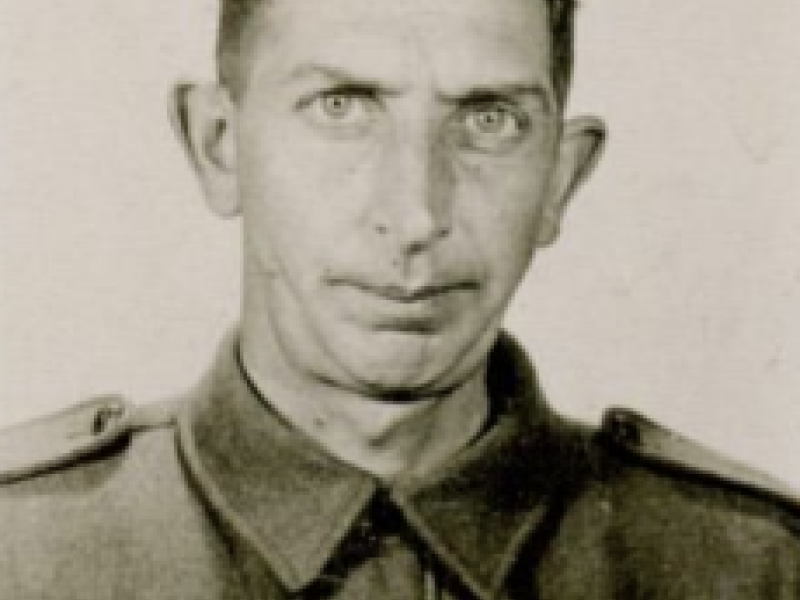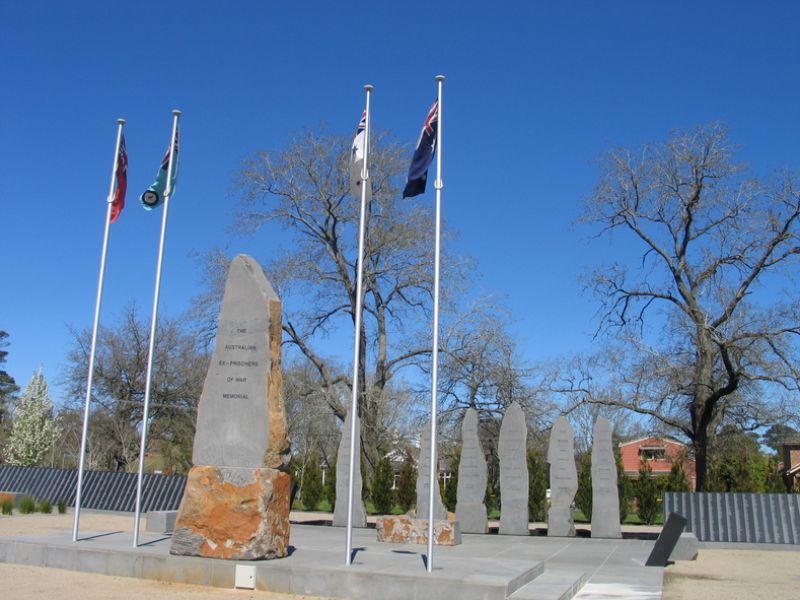Maurice Bailey
Maurice was born on the 30th of August, 1907, at Corryong, Victoria. He would be the second of eight children to David Richard and Grace Victoria (née Bell) Bailey. The 1930 Australian Electoral Roll shows that maurice was living at 539 Schubach Street in Albury and was working as a labourer. In 1931 he married Georgina Alecia (Jean) Watkins. They lived in Albury and would have three sons between 1932 and 1937. By 1937 the family was living in Wagga Road.Maurice (whose name would have certainly been shortened to Maurie), enlisted at Caulfield on the 6th of June, 1940. He was allocated the Army Number VX22894 and posted to C Company of the 2/2nd Pioneer Battalion based at Puckapunyal in central Victoria. In the group photograph he is seated in the second back row, sixth from the left. While in camp he was billeted in Hut B7. Towards the middle of his training period he was admitted to the 4th Australian General Hospital on the base suffering from cellulitus in his left leg. He would remain in hospital for over four weeks.
The battalion embarked at Sydney on the 7th of April, 1941 on the Queen Mary. The battalion was accommodate on the Main and A Decks. The ship arrived at Jervis Bay two days later and waited there to join a convoy of other ships. Leaving Jervis of the 11th the Queen Mary made its may to Port Tewfik, Egypt via Fremantle and Trincomalle, Ceylon. Upon arriving at Port tewfik the troops transhipped to the SS Ethopia for the seven hour trip through the Suez Canal to El Kantara in the north. On May the 5th it entrained at El Kantara for Hill 95 Camp in Palestine.
On the 13th of June, C Company experienced its first action (the other Companies had previously been in action) against Vichy French forces. Five days later Maurice was injured in action. He was taken to the 7th Australian General Hospital where it was discovered that he had fractured his right hand sides ribs. After a period in hospital and then a convalesecent depot he rejoined his unit on the 25th of July, 1941.
In early November he was admitted to the 2/1st Casualty Clearing Station suffering from jaundice. He would not rejoin his battalion until the 20th of December. On the last day of January, 1942, the 2/2nd Pioneer Battalion embarked on the SS Oracades. At 0930 hours on the 1st of February, the Orcades left Port Tewfik and proceeded through the Suez Canal.
Unbeknown to the Australian units onboard, which included the 2/2nd Pioneers and the 2/3rd Machine Gun Battalion, the Orcades was involved in a political game of chess between the Australian and English Governments. Churchill wanted the units to be used in the defence of Burma while John Curtin (Australia’s Prime Minister) wanted them home to be used for home defence. Churchill even called upon the American President Roosevelt to add pressure to the Australian Government and in a typical “Churchillian” move had already ordered the convoy to change course to Rangoon, the capital of Burma. Upon Curtin discovering this, Churchill’s reply was “we could not have contemplated that you would refuse our request and that of the President of the United State for the diversion of the leading Australian division to save the situation in Burma.”
General Wavell (Commander-in Chief of the America-British-Dutch-Australian Command, formed when war broke out with the Japanese) informed Curtin that Java faced imminent invasion and that Australia’s outer dfences were quickly vanishing and that the government’s primary obligation was to save Australia. Churchill caved in and the Orcades changed course for Java.
On the day that the Orcades moved into Tandjoeng Priok, the port of Batavia in Java, Singapore surrendered. The battalion dismebarked on the 18th of February and were moved to defend the airport At Tjililitan against Japanese paratroopers. Three days later B and C Companies were transported 40 miles south to defend the airport at Semplak. What followed was eleven days of moving and holding on, fighting against well trained and battle hardened troops along with tanks. The Japanese also had control of the seas and the skies.
On the 8th of March, Dutch forces surrended, adding more pressure onto the Commonwealth Forces who were fighting on. The following day all existing forces surrended. Maurice was now a prisoner of the Japanese. By April, C Company was most likely at the Bicycle Camp at Batavia. On the 8th of October, Maurice would have been of the group embarked on the hellship Kenkon Maru and then sent to Changi Camp in Singapore as part of Williams (Lieutenant Colonel Wiliams, CO of the 2/2nd Pioneers)Force. By the 23rd of October this force had been shipped from Singapore to Rangoon, Burma on the Maebashi Maru. The following day it boarded the Yamagata Maru for the trip up the Salween River to Moulmein, Burma. It then joined Black Force and marched to the South Moulmein Station where they 30 men and their gear were packed into steel boxcars used to transport rice.
By the 29th of October, Maurice would have found himself at the 35 Kilo Camp (Tanyin) working on the Burma-Thailand Railway. It’s recorded that Maurice died on the 1st of November, 1943, from tropical ulcers. Corporal Tom Fagan (VX47533) was a member of the 105 General Transport Company and a POW of the Japanese on the Burma-Thai Railway. In Leslie Hall’s evocative book “Blue Haze - POW’s on the Burma-Thai Railway” he include’s Tommy’s diary from when he worked on the railway.
“24th July 1943
…The smell of my ulcer is worse than what comes from a dead, decaying body … My shin bone is exposed; looks green as the flesh is rotting away. Now i can feel sores coming onto my back. Bamboo slat knots press hard against skin. Lots of boys have them.”
After the war, Maurice’s remains were transferred from the camp burial ground that he died at to the Thanbyuzayat War Cemetery in Myanmar. He is remembered on the Australian War Memorial Roll of Honour, and the Ex-Prisoners of War Memorial at Ballarat. For his service, he was awarded the 1939-1945 Star, the Africa Star, the Pacific Star, the Defence Medal, the War Medal 1939-1945 and the Australian Service Medal 1939-1945.

 Stephen Learmonth
Stephen Learmonth